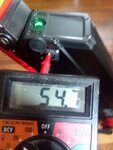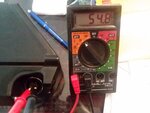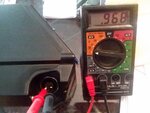Hullo All in Juiced Bikes (JB) Land. I have hesitated to do this post as, on the surface, it may well seem trivial to some, if not all lovers of JB e-bikes. But, it is equally about JB's customer support quality as well as batteries per se - so here goes.
As background I have a JB CrossCurrentX (CCX) with the 52V-19.2Ah battery pack. I enjoy the bike and am impressed generally, but as I load the bike close to its 275lb limit I am concerned with maximizing performance especially as I note that it starts to tail off approaching a 50% State of Charge (SoC). Given my weight, lack of fitness and other health issues - a key marketing demographic for e-bike buyers I suspect - I need solid assist - every pun intended.
The issue that I have tried to address, and failed, through JB support is that the standard charger results in a maximum SoC of 57.7V, ie, some 93%. "So what" some may say; what does it matter to miss out on the final 7% of charge. Well, given I see a lessening of assist at 50%, my Fun Range of charge is 50% to 93%, ie, 43%. Obtaining that additional 7% is a Fun Range percentage improvement of >16% and, within the best performance (voltage) range of all to include less amperage draw for any particular power (watts) requirement.
Please, also note, that we are discussing - given an extra cent - a $1,300 asset. I would like the option to decide what SoC I use for my battery and not be arbitrarily restricted by JB and for no reason given, indeed, resolutely refused. Please also note that while JB claim (see item #7 in article https://support.juicedbikes.com/hc/en-us/articles/360026938792) that the charger stops at 95%, the BMS puts out a spoofed voltage of 58.7 to 58.8 V thereby indicating a fully charged pack when it is at 57.7V [my standard JB charger is rated as and puts out an honest, ie, measured 58.8V]. That is, there is always a +0.90 to 0.99V Guard Voltage added to the pack's internal voltage. Please refer to 'attached' PDF file: Battery Voltage Levels.
The primary reason for this post is to bring to the attention of those that might be interested in such things not only of the spoofing a fully charged state and how to counter that to achieve a full 100% SoC; but, also, JB support staff's obfuscation on the matter in general; and, their complete intransigence - their utter refusal - to answer that simple question; in essence, if I obtain such as a GRIN Satiator can I program for 59.8V (58.8 +1 for the Guard voltage) and thereby achieve 100% SoC?
During the various communications with JB staff I received at least four separate and different explanations. Please refer to PDF file FOUR REASONS FOR GUARD VOLTAGE - EXTRACTS, 'attached'. For a "...Chapter & Verse" documentation trail - and if so inclined - please refer to 'attached' PDF file JUICED BIKES FOUR REASONS FOR STANDING VOLTAGE.
Perhaps two or three of you in this community with the 52/19.2 pack will measure voltage at the discharge port (feed to Controller Unit (CU)) with the pack powered OFF as well as ON; for the latter also record, once the battery is remounted, the voltage shown by the CU via the handlebar display?
Perhaps I do have a bad pack? But I suspect not within the general scheme of things.
Do JB have something to hide? What? Why? Especially the refusal to even discuss how to charge to 100%? Pre-emptive strike against users leaving packs at 100% and making warranty claims. Weak architecture? Older kit press ganged into a pseudo 52V world that (may) exceed their (original) design limits? Why the "...secrecy"? Who Can Say?
As background I have a JB CrossCurrentX (CCX) with the 52V-19.2Ah battery pack. I enjoy the bike and am impressed generally, but as I load the bike close to its 275lb limit I am concerned with maximizing performance especially as I note that it starts to tail off approaching a 50% State of Charge (SoC). Given my weight, lack of fitness and other health issues - a key marketing demographic for e-bike buyers I suspect - I need solid assist - every pun intended.
The issue that I have tried to address, and failed, through JB support is that the standard charger results in a maximum SoC of 57.7V, ie, some 93%. "So what" some may say; what does it matter to miss out on the final 7% of charge. Well, given I see a lessening of assist at 50%, my Fun Range of charge is 50% to 93%, ie, 43%. Obtaining that additional 7% is a Fun Range percentage improvement of >16% and, within the best performance (voltage) range of all to include less amperage draw for any particular power (watts) requirement.
Please, also note, that we are discussing - given an extra cent - a $1,300 asset. I would like the option to decide what SoC I use for my battery and not be arbitrarily restricted by JB and for no reason given, indeed, resolutely refused. Please also note that while JB claim (see item #7 in article https://support.juicedbikes.com/hc/en-us/articles/360026938792) that the charger stops at 95%, the BMS puts out a spoofed voltage of 58.7 to 58.8 V thereby indicating a fully charged pack when it is at 57.7V [my standard JB charger is rated as and puts out an honest, ie, measured 58.8V]. That is, there is always a +0.90 to 0.99V Guard Voltage added to the pack's internal voltage. Please refer to 'attached' PDF file: Battery Voltage Levels.
The primary reason for this post is to bring to the attention of those that might be interested in such things not only of the spoofing a fully charged state and how to counter that to achieve a full 100% SoC; but, also, JB support staff's obfuscation on the matter in general; and, their complete intransigence - their utter refusal - to answer that simple question; in essence, if I obtain such as a GRIN Satiator can I program for 59.8V (58.8 +1 for the Guard voltage) and thereby achieve 100% SoC?
During the various communications with JB staff I received at least four separate and different explanations. Please refer to PDF file FOUR REASONS FOR GUARD VOLTAGE - EXTRACTS, 'attached'. For a "...Chapter & Verse" documentation trail - and if so inclined - please refer to 'attached' PDF file JUICED BIKES FOUR REASONS FOR STANDING VOLTAGE.
Perhaps two or three of you in this community with the 52/19.2 pack will measure voltage at the discharge port (feed to Controller Unit (CU)) with the pack powered OFF as well as ON; for the latter also record, once the battery is remounted, the voltage shown by the CU via the handlebar display?
Perhaps I do have a bad pack? But I suspect not within the general scheme of things.
Do JB have something to hide? What? Why? Especially the refusal to even discuss how to charge to 100%? Pre-emptive strike against users leaving packs at 100% and making warranty claims. Weak architecture? Older kit press ganged into a pseudo 52V world that (may) exceed their (original) design limits? Why the "...secrecy"? Who Can Say?



